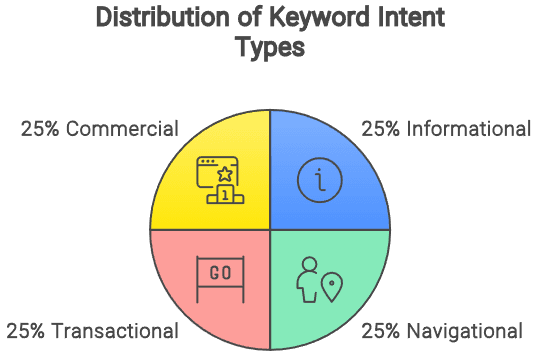Keyword research for SEO remains the cornerstone of every successful digital marketing strategy. By identifying the precise terms your audience searches for, you create content that aligns with their needs while satisfying search engine algorithms. This guide explores advanced techniques, tools, and actionable strategies to elevate your SEO game.
Understanding Keyword Intent: The Foundation of Effective SEO
Keyword intent—often called search intent—determines why users type specific queries into search engines. A search for “best CRM software” indicates commercial research, while “how to install WordPress” reflects informational needs. Aligning content with intent ensures relevance, boosts rankings, and drives conversions.
The Four Types of Keyword Intent
Search intent falls into four categories, each requiring tailored content strategies:
| Intent Type | Description |
|---|---|
| Navigational | Users seek a specific website (e.g., “Facebook login”). |
| Informational | Users want answers (e.g., “how to fix a leaky faucet”). |
| Commercial | Users compare products (e.g., “top project management tools 2024”). |
| Transactional | Users are ready to buy (e.g., “buy organic coffee beans online”). |

Misinterpreting intent leads to high bounce rates. For example, targeting transactional keywords with informational content frustrates users and signals poor relevance to search engines. Tools like our Free Keyword Research Tool help identify intent by analyzing search volume, competition, and related queries.
Why Intent Matters
Google’s algorithms prioritize user satisfaction. A Semrush study found that pages matching search intent rank 3x higher. To optimize:
- Analyze top-ranking pages for your target keyword.
- Structure content to answer the user’s underlying question.
- Use semantic keywords like “guide,” “review,” or “buy” to signal intent.
For deeper insights, explore our guide on How to Do Keyword Research.
Leveraging Long-Tail Keywords for Higher Conversions
Long-tail keywords—phrases with three or more words—capture niche audiences with clear intent. While they have lower search volumes, they often convert 36% better than generic terms (The HOTH).
Benefits of Long-Tail Keywords
| Advantage | Impact |
|---|---|
| Lower Competition | Easier to rank for, especially with newer websites. |
| Higher Conversion Rates | Targets users further along the buyer’s journey. |
| Cost-Effective Traffic | Reduces paid ad spend while boosting organic ROI. |
Example: Instead of competing for “SEO tools,” target “free SEO tools for small businesses.”
Strategies to Find Long-Tail Keywords
- Use AnswerThePublic: Visualize questions users ask around a topic (e.g., “how to use keyword research tools”).
- Analyze Google Suggestions: Type your main keyword into Google and note autocomplete prompts.
- Mine Competitor Content: Tools like Competitor Keyword Analysis reveal gaps in their strategies.

Pair long-tail keywords with high-quality content, like our Content Marketing Strategies, to maximize visibility.
Free Keyword Research Tools: Power Your SEO Without a Budget
You don’t need expensive software to execute effective keyword research for SEO. These free tools deliver enterprise-level insights:
1. Google Keyword Planner
Ideal for uncovering search volume and competition data. Simply enter a seed keyword to generate hundreds of related terms.
| Feature | Use Case |
|---|---|
| Search Volume | Identify high-traffic keywords. |
| Competition Level | Gauge difficulty to rank. |
| Keyword Suggestions | Discover long-tail variations. |
2. Ubersuggest
This tool provides SEO difficulty scores, content ideas, and backlink data. For example, typing “local SEO” reveals subtopics like “local SEO checklist” or “local SEO services pricing.”
3. RWST’s Free Keyword Generator
Our Advanced Keyword Research Tool filters keywords by intent, difficulty, and trend data. Export lists directly to your SEO workflow.
For a full toolkit, explore our Top 10 SEO Tools for 2024.
Analyzing Keyword Competition: Outrank Your Rivals
Keyword difficulty (KD) measures how hard it is to rank for a term. Use these metrics to prioritize low-hanging opportunities:
Factors Affecting Keyword Difficulty
| Factor | Why It Matters |
|---|---|
| Domain Authority (DA) | High DA sites dominate competitive keywords. |
| Content Depth | Comprehensive guides outrank thin content. |
| Backlink Profile | Quality backlinks signal authority to search engines. |
Pro Tip: Target keywords with a KD score below 40 if your site’s DA is under 50. Tools like Website Competition Test simplify this analysis.
Competitor Analysis Tactics
- Reverse-Engineer Their Keywords: Use SEMrush to spy on competitors’ top-performing pages.
- Identify Content Gaps: Find keywords they rank for but haven’t covered thoroughly.
- Monitor Their Backlinks: Tools like Ahrefs reveal where they acquire links—replicate their strategy.
Strengthen your backlink profile using our Off-Page SEO Strategies.
Final Thoughts
Mastering keyword research for SEO requires blending intent analysis, long-tail targeting, and competitive insights. By leveraging free tools and data-driven strategies, you can transform your website’s visibility and drive sustainable growth. For ongoing optimization, explore our SEO Best Practices for 2024 and stay ahead of algorithm updates.
